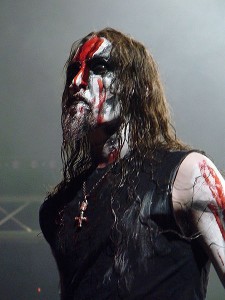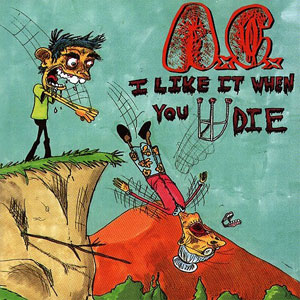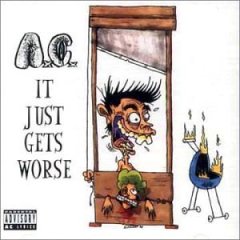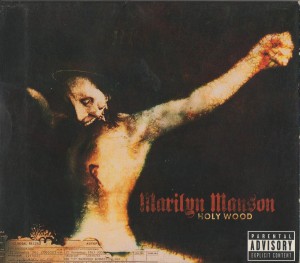 In case you weren’t watching TV that day—any channel, at any given moment—on April 20, 1999, two black-clad teenage boys walked into their high school in Littleton, CO with an action hero’s arsenal of guns and homemade explosives. They had prepared for over a year, alternately referring to their plot as “Judgement Day” or “NBK”—after Natural Born Killers. The bombs were set to destroy the entire cafeteria, but when they failed to blow, the two boys proceeded to shoot and kill twelve students and one teacher in a sixteen minute rampage. Over two dozen others were wounded. A few are crippled for life.
In case you weren’t watching TV that day—any channel, at any given moment—on April 20, 1999, two black-clad teenage boys walked into their high school in Littleton, CO with an action hero’s arsenal of guns and homemade explosives. They had prepared for over a year, alternately referring to their plot as “Judgement Day” or “NBK”—after Natural Born Killers. The bombs were set to destroy the entire cafeteria, but when they failed to blow, the two boys proceeded to shoot and kill twelve students and one teacher in a sixteen minute rampage. Over two dozen others were wounded. A few are crippled for life.
After a brief standoff with the police, Eric Harris and Dylan Klebold sat down side-by-side in the school library, lit one last Molotov cocktail, and blew their brains out in turn. Marilyn Manson wrote an entire album about it. He called it Holy Wood.
It bears repeating here that Marilyn Manson’s name was taken from Marilyn Monroe and Charles Manson, the most popular sex symbol and murder icon of the Woodstock Generation. Marilyn Manson was conceived as a collective symbol for America, combining polar opposites: male and female, beauty and ugliness, Eros and Thanatos, God and Satan.
His early persona was like a luciferic Cat in the Hat taunting Jerry Falwell on a Saturday morning cartoon. The sleeve of his 1994 debut album features the singer’s face grinning on a television set above a young boy smeared with make-up and holding a revolver.
As a sort of disclaimer in his first newsletter, Mr. Manson made it clear to his growing cult of adoring adolescents that killing one’s parents or oneself “has no place in our movement.” He wasn’t building an army to fill a graveyard. He wrote:
“When WE become the majority, we will decide who ‘doesn’t belong.’ As misanthropes and throw-away kids we will not submit to mainstream. We will become it. And America should be very, very afraid.”
Small-town parents were horrified to see their kids wearing playful t-shirts that read WE HATE LOVE—WE LOVE HATE, and the classic:
Warning: the music of Marilyn Manson
contains messages that will
KILL GOD
in your impressionable teenage minds.
As a result, you could be convinced to
KILL YOUR MOM & DAD
and eventually in an act of hopeless
“rock and roll” behavior you will
KILL YOURSELF
Please burn your records
while there’s still hope
With the release of Antichrist Superstar in 1996, Manson’s following grew exponentially. The album is a satire on the self-righteous shit-flinging between America’s polarized moralists. Playing upon the premillennial tension of the late 90s, Manson describes the so-called Antichrist as a hateful force lurking within each of us. The story’s protagonist is an alienated boy who becomes so infected with his culture’s megalomaniacal intolerance that he is ready to destroy the whole world in a sort of suicide/apocalypse:
I went to God just to see
And I was looking at me
Saw Heaven and Hell were lies
When I’m God, everyone dies
The album went platinum. Liberal politicians called it sick and offensive, while Christian protesters swarmed to arenas with picket signs, driving ticket sales through the roof. In concert, Manson stood on a podium reminiscent of Nuremberg or The Wall, tore pages from the Bible, and instructed his fans to spit loogies all over him.
“They want you to go to church,” he screamed, “but this is your church, motherfuckers!”
The message of his sermon?
“Be yourself.”
In 1998, Manson finally broke into the global mainstream with Mechanical Animals, a glam-inspired concept album poking fun at the bland MTV rock culture of the day. An androgynous alien descends to Earth lookin’ for love, only to find a dying world populated by doped-up, dumbed-down automatons “as hollow as the ‘o’ in God.” The album debuted at #1, and “the world spread its legs for another star.” The Rock is Dead tour sold out arenas, with Manson poised to become “bigger than Satan.” But there was trouble popping off behind the scenes.
✝✝✝
Throughout Manson’s rise to superstardom, school shootings ramped up at an alarming rate. All across America, small-town white boys were arming themselves and waging war on the world:
- October 12, 1995—Blackville, SC. A 16 year-old shot and killed two math teachers before shooting himself.
- November 15, 1995—Lynnville, TN. A 17 year-old shot three people, killing a teacher and an 8th grader before he was tackled.
- - February 2, 1996—Moses Lake, WA. A 14 year-old came to his algebra class in a long black coat. He shot and killed two students and a teacher, saying “This sure beats algebra, doesn’t it?” The line came from Stephen King’s novel Rage. The killer said his outfit was inspired by a scene in Natural Born Killers.
- February 8, 1996—Pala Alto, CA. A 16 year-old drove his car onto an outdoor basketball court, tossed dollar bills out the window, and unloaded on the kids running up to grab the money, injuring three before killing himself.
- - February 19, 1997—Bethel, AK. A 16 year-old went on a twenty minute spree, killing his principal and a student, injuring two others. He held the gun to his own head before surrendering to police.
- October 1, 1997—Pearl, MS. A 16 year-old self-proclaimed Satanist and Hitler fan smothered his mother with a pillow, beat her with a baseball bat, and stabbed her to death with a kitchen knife. He then went to his school and shot his ex-girlfriend before firing at random, ultimately killing two and wounding seven.
- December 1, 1997—West Paducah, KY. A 14 year-old tried to impress the goth crowd by shooting up a prayer circle at school, killing three and injuring five. A copy of King’s Rage was found in his locker.
- December 6, 1997—Stamps, AR. A 14 year-old hid in a treeline and fired on students walking to class, injuring two.
- - March 24, 1998—Jonesboro, AR. Inspired by the Stamps shooting, two boys—13 and 11 years-old—stole various firearms and a van, then drove their arsenal to their middle school. The younger boy pulled the fire alarm, then ran to the woods to join his friend. As the students filed out, the pair fired 30 rounds, killing four preteen girls and one teacher, injuring ten others.
- April 24, 1998—Edinboro, PA. A 14 year-old shot and killed a teacher and wounded two classmates at a graduation dance.
- May 21, 1998—Springfield, OR. A 15 year-old killed his parents and booby trapped their bodies with homemade bombs. He then went to school, where he fired on 400 students in the school cafeteria, killing two and wounding twenty-two.
In each of these cases, the shooter was a rural (or suburban) white male. It was like a psychopathic version of Revenge of the Nerds. None of the shooters were high up on the school pecking order—many were at the bottom of the food chain. All of them were either bullied (typically called “faggots”), sexually abused, compelled by a desire to prove their masculinity, suffering from feelings of persecution, desperately suicidal, or some combination thereof. It goes without saying that they all had access to guns.
Eric Harris and Dylan Klebold had been watching these tragedies unfold on television. “Every day news broadcasts stories of students shooting students, or going on killing sprees,” Eric wrote in an English paper. “It is just as easy to bring a loaded handgun to school as it is to bring a calculator.”
“Thorough and logical,” his teacher remarked. “Nice job.”
Eric was particularly taken by the meticulously planned massacre in Jonesboro, AR, and was itching to top the young pair’s body count. A competitive egomaniac, Eric even aspired to top the 168 deaths caused by Timothy McVeigh. Eric and Dylan’s “Judgement Day” was originally planned for April 19, 1999—the 4th anniversary of the Oklahoma City Bombing—but due to a delay obtaining ammunition, they settled for Hitler’s birthday instead. They dreamed big, and even discussed hijacking a plane to crash into a building in Manhattan, but their high school was more realistic. They constructed numerous propane bombs intended to collapse the columns in the cafeteria, which would send the library upstairs crashing down. They hoped to kill at least 500 students, and would shoot any survivors running out of the building.
“it’ll be like the LA riots, the oklahoma bombing, WWII, vietnam, duke and doom all mixed together,” Eric wrote. “maybe we will even start a little rebellion or revolution to fuck things up as much as we can. i want to leave a lasting impression on the world.”
In the end, they killed thirteen people and then themselves—undoubtedly, the impression was lasting. News teams descended on Littleton in droves. CNN and Fox News charted the highest ratings in their history, and proclaimed Columbine to be the bloodiest school shooting ever recorded—and recorded live, to boot. Billy Graham’s son, Franklin, arrived with Amy Grant by his side to lead the mourners in prayer. Pop psychologists built entire careers around the shooting. Souls would be saved. Psyches would be probed. History would be made.
Before the day was over, Marilyn Manson became an instant scapegoat, carrying the sins of America’s homocidal youth. Headlines read: KILLERS WORSHIPPED ROCK FREAK MANSON and SHOCK ROCKER WHO FILLED PAIR WITH A THRILL TO KILL. He certainly looked the part.
Of course, the original claims that Eric Harris and Dylan Klebold were dressed like Manson were completely false, but first impressions tend to stick. Eric was obsessed with KMFDM, and Dylan listened to Nine Inch Nails’ The Downward Spiral again and again. It is certainly possible that they listened to Marilyn Manson as well, as some students claimed—or maybe they always thought he was “a joke,” as the killers were later quoted as saying.
Manson watched in horror as his contacts in show business and the music industry turned their backs on him one by one. Anonymous death threats began arriving soon after.
About a month after the shooting, Manson published an article in Rolling Stone entitled “Columbine: Whose Fault Is It?” He held violent human nature responsible for such tragedies, played upon by religion and mass media:
Christianity has given us an image of death and sexuality that we have based our culture around. A half-naked dead man hangs in most homes and around our necks…The world’s most famous murder-suicide was also the birth of the death icon—the blueprint for celebrity…
[The media] just created two new [folk heroes] when they plastered those dipshits Dylan Klebold and Eric Harris’ pictures on the front of every newspaper. Don’t be surprised if every kid who gets pushed around has two new idols.
Manson does take on some of the blame, however, by virtue of his membership in the intrinsically violent human race:
In my work I examine the America we live in, and I’ve always tried to show people that the devil we blame our atrocities on is really just each one of us.
That said, the singer crawled into his attic for three months, where he wrote Holy Wood (In the Shadow of the Valley of Death). The record was released on November 14, 2000—just before the deathday of JFK—along with this on Manson’s website:
Is adult entertainment killing our children?
Or is killing our children entertaining adults?
✝✝✝
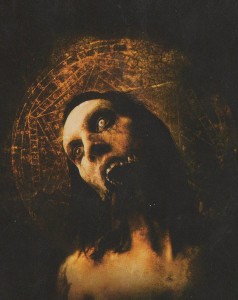 Holy Wood approaches these questions with morbid curiosity rather than definitive answers. In some ways, Marilyn Manson shows more empathy for the troubled kids gathering in his shadow than on any other album. The narrative is cohesive and lucid as the inner world of a teenage killer unfolds with each song.
Holy Wood approaches these questions with morbid curiosity rather than definitive answers. In some ways, Marilyn Manson shows more empathy for the troubled kids gathering in his shadow than on any other album. The narrative is cohesive and lucid as the inner world of a teenage killer unfolds with each song.
The album opens with a child’s prayer. God is Jesus Christ hanging on a cross. God is John F. Kennedy shot in the black limousine. God is John Lennon in the happy gun. God is a child killed on camera. God is dead, and so everybody loves him.
Manson elaborates on “Lamb of God”:
If you die when there’s no one watching
Then your ratings drop and you’re forgotten
If they kill you on their TV
You’re a martyr and the lamb of God
Columbine, the 2009 exposé by Dave Cullen, explores Eric and Dylan’s aspirations to televised deification in uncomfortably vivid detail, as well as providing heart-wrenching accounts of the victims, the survivors, and their families. Cullen draws on documents that were sealed during much of the media circus surrounding the tragedy, including the boys’ journals.
Eric Harris proudly entitled his writings The Book of God. The first line reads: “I hate the fucking world.” Further on, he writes:
“I feel like God. I am higher than almost anyone in the fucking world in terms of universal intelligence…ever wonder why we go to school? its not to obvious to most of you stupid fucks but for those who think a little more and deeper you should realize it is societies way of turning all the young people into good little robots.”
Despite these god-like flights of fancy, Eric was an avowed atheist disgusted by the megachurch-attending Christians that thrive in Littleton. “its just all nature, chemistry, and math. you die. burn, melt, evaporate, decay.” From this standpoint, he adopted a Nazi-like view of evolution.
In Eric’s twisted peanut, natural selection has been hijacked by medical care and special ed programs, leaving him surrounded by retarded automatons who not only refused to bow down, but had the nerve to insult him continually. Among his proposed solutions was to imprison the human race in an Ultimate Doom game and pick us off one by one. Another option, meticulously detailed in his writing, was “Judgement Day.”
“I know I will die soon; so will you and everyone else.”
Despite the constant irritation, Eric revelled in his ascendant position as the highest lifeform on Earth. For Dylan Klebold, being unique was depressing.
Dylan called his journal Existences: A Virtual Book. It’s pages are filled with sadness creeping toward suicide. “My existence is shit,” he wrote.
Dylan lamented his inability to shake society’s droids from their torpid ignorance. Early on, he only wanted to set “the zombies” free. While Eric was a hater who still managed to get laid now and again, Dylan was a lover who pined after girls in vain. The pages of Existences are filled with sketches of floating hearts surrounded by stars. He doted over the smallest details of his highschool crushes. These girls would never understand the universe opening up in his teenage mind.
A firm believer in God, Dylan tortured himself with the struggle between good and evil, Heaven and Hell. He frequently purified himself of vices such as playing Doom, watching porno, drinking booze, and notably, making fun of other kids—which he and Eric did relentlessly. Dylan’s soul was threatened with damnation, while on earth his fragile ego was menaced by the persecution of his peers. The slightest insult could send him spiraling into a vicious, overly-defensive tantrum. Again and again, he wrote, “the screws are tightening.” In the end, he followed his friend Eric to the only freedom he could imagine: NBK.
Holy Wood’s primary narrator is Adam Kadmon, who embodies the universal innocence of mankind. The naive Adam wants to change the world—to start a revolution that will free its inhabitants. He pursues the love of humanity, personified as his Eve (called Coma Black.) But in the end, she is just another plastic doll “the color of TV,” and so Adam decides to end the world that refuses to be saved on his terms.
The climax of the album is the frantic industrial track “King Kill 33°”. The title comes from James Shelby Downard’s freaked out conspiracy theory tract of the same name, which reconstructs the Kennedy assassination as a ritual sacrifice orchestrated by the Freemasons in order to harness the public’s emotional response through sorcery. In the song, the rejected Adam Kadmon turns against the world in fury, then becomes a dying god in his own mind:
But I have to show you that you played a role
And I will destroy you with one simple hole
The world that hates me has taken its toll
But now I have finally taken control
You wanted so bad to make me this thing
And I want you now to just kill the king…
And I am not sorry, and I am not sorry,
This is what you deserve
✝✝✝
There is always the question of blame whenever blood is spilled—without an answer, a killing becomes meaningless. Eric held the world responsible for its own destruction—people were just too stupid to live. His t-shirt on the day of the massacre read “Natural Selection.” (How ironic that he selected himself out of the gene pool.) Dylan blamed God for being so indifferent to his suffering. His t-shirt said “Wrath.”
After Columbine, evangelical Christians were quick to claim that Satan kills kids for lack of Jesus. Gun control advocates kept their sites on “the great equalizer” that allows anyone with a strong finger to end someone else’s world. Anti-bullying activists and minority advocates insisted that if everyone was just nice to everyone else all the time, kids would have no reason to kill. Various pop psychologists and political action committees pointed fingers at violent video games, violent movies, and yes, violent music as being the examples from which killers learn their behavior.
Dave Cullen promotes the FBI’s conclusion that, in the case of Columbine, neurological predisposition was to blame. Criminal psychologists determined that Eric Harris was a textbook psychopath—a sadistic manipulator and compulsive liar without the biological prerequisites to feel empathy. His sidekick Dylan was just a chronic depressive for whom the vacuum of despair opened a space for murder. In this reductionist view, Nature simply produces diabolical genetic aberrations here and there, making human reproduction into a game of Russian roulette that will periodically put a murderer under the firing pin. For Cullen, Eric Harris was a natural born killer, no matter what kind of music he liked.
Media coverage of the Columbine shooting sensationalized the link between rock n’ roll and violence, as they did with Charles Manson and The Beatles’ White Album, or Richard Ramirez and AC/DC’s Highway to Hell. Maybe the borderline retarded Seung-Hui Cho unloaded clip after clip—killing 32 fellow Virginia Tech students—because he listened to Collective Soul’s “Shine” a hundred million times.
So what album was 23 year-old Wellington Oliveira listening to earlier this month when he systematically executed twelve small children at his old elementary school in Rio de Janeiro? That is uncertain, but we do know that he was inspired by Cho and a previous Brazilian school shooter, calling them his “brothers” in the fight against the bullies of the world.
Cho considered Harris and Klebold to be “martyrs” for the cause, and Eric Harris was inspired by the school shooting in Jonesboro, AR—just as that incident was an imitation of a previous school shooting in Arkansas. Like Harris, Klebold, and Cho, Oliveira left rambling video messages which put the blame for his murderous rampage on the world that persecuted him. “Each time you see someone making fun of someone else for their physical appearance, the clothing or any reason…remember that type of person is responsible for all these deaths, including my own.”
By their bloodthirsty nature, the news media then broadcasted each losers’-call-to-arms to the next psycho turning in the pistol’s chamber. Loren Coleman’s research into “the copycat effect” gives strong evidence that mass shootings and suicides come in clusters, beginning with one widely publicized incident. It seems that at any given moment there are a handful of wackos ready to snap, and seeing a gruesome news story validates their rage.
Despite recent claims that school shooters are typically not bullied outcasts, the most notorious school shooters complained of being disrespected, shunned, insulted, and/or beaten up by their peers. Whether they were just being hyper-sensitive whiners or were viciously attacked, in their own minds they were backed into a corner. Taking it on the chin was not an option. The indignities of life stuck to their souls, and revenge was the only purification.
In the early days, Marilyn Manson often spoke of his resentment at being bullied in school. He was tall, gangly, and weird, so naturally kids beat the shit out of him. For him, becoming a rock star was the greatest revenge he could have on his tormentors. He realized his vindictive impulses through art rather than with a gun, and kept his dick wetter than most for the effort.
Amplifiers cranked Brian Warner’s otherwise soft spoken murmer up to Marilyn Manson’s ear-drilling shriek, drowning out parents and priests. Recording technology allowed him to break free from the ancient male pecking order by catching the camera’s eye and enticing the kiddie Id with taboo urges. It is no surprise that people would find links between Manson’s music and hate-filled teenagers—they occupy the same spiritual space. No salvation. No forgiveness.
Show biz is a dirty business. For all of his accusations that the media exploits tragedy for profit, Manson has sold over 9 million copies of Holy Wood to date.
Civilization has provided numerous ways to get around the rulership of brute force, including intelligence, cooperation, rhetoric, and art. Eric Harris and Dylan Klebold utilized a relatively new technological alternative to liberate themselves: the gun.
For millennia, evolution selected for males endowed with physical prowess. Tribal leadership was granted to the greatest warriors. By the dawn of written history, mankind had created swords to maintain worldly power. This gave some smaller men an edge, but a sword still requires strength and dexterity to wield. The revolver is a kid’s toy.
The rough-and-tumble environment of the schoolyard mimics the ancient environment, where the strongest muscles command the most respect and the frail are casually knocked out of the way. I imagine that weaklings have resented the blows dealt by stronger hands since vivid cerebral memory overtook blessed animal forgetfulness, but they were always powerless to do anything about it.
Today, the availability of guns provides an avenue to subvert this carnal hierarchy, granting power to the weak and the despised. In the blink of a scowling eye, any idiot with an opposable thumb and an itchy trigger finger can momentarily claim the ultimate right of an earthly King: the power to deal death as he chooses. The popular media then line up to give voice to this whimpering proclamation of sovereignty.
In typical amoral fashion, Manson screams:
This is evolution
The monkey, the man
Then the gun
The possibility that unhinged individuals might draw destructive inspiration from such dismal visions should be unsettling—but not nearly so disturbing as the human condition that these expressions describe. Sadly, as long as there are cameras, guns, and psychotic discontents, Holy Wood will continue to be a relevant piece of art.
© 2011 Joseph Allen
Marilyn Manson — “The Nobodies”
2001
Sources
Coleman, Loren. The Copycat Effect: How the Media and Popular Culture Trigger the Mayhem in Tommorrow’s Headlines. New York: Paraview Pocket Books, 2004.
Cullen, Dave. Columbine. Boston: Twelve, 2009.
Newman, Katherine S. Rampage: The Social Roots of School Shootings. New York: Basic Books, 2004.
